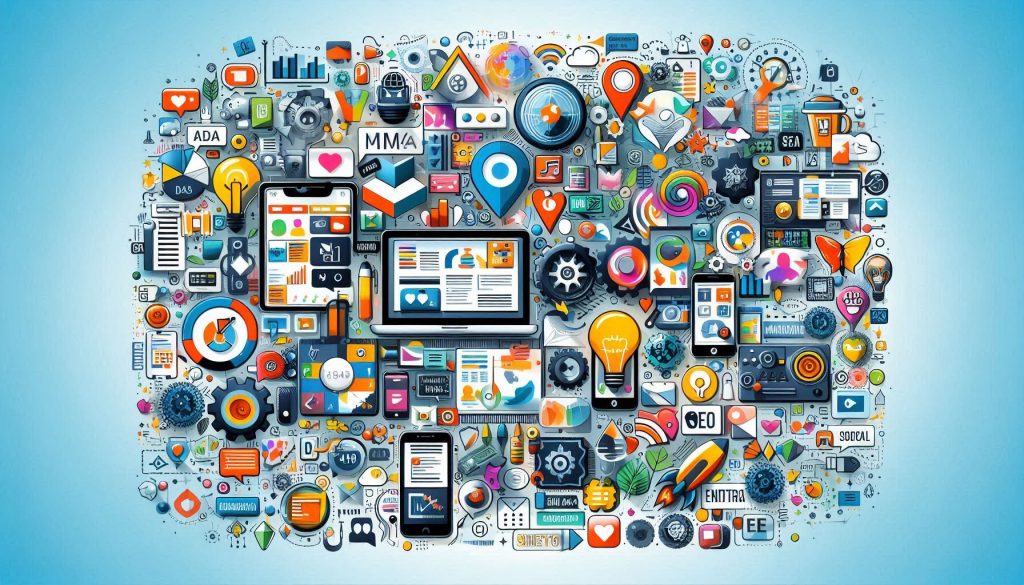In digital marketing, strategies are executed through online channels, while traditional marketing focuses on offline tactics. Digital marketing leverages social media, email, and SEO to reach audiences, whereas traditional marketing includes print, TV, and radio ads.
Digital marketing and traditional marketing are both essential components of any successful marketing strategy. While traditional marketing tactics are rooted in long-standing practices like print advertisements, television spots, and billboards, digital marketing leverages online channels like social media, email, and search engine optimization to reach and engage audiences.
As technology continues to evolve, the line between digital and traditional marketing continues to blur, making it essential for businesses to have a comprehensive understanding of both to effectively reach their target audiences.
The Evolution of Marketing
Marketing has undergone a significant transformation over the years, adapting to the ever-changing landscape of technology and consumer behavior. From traditional methods to the digital age, the evolution of marketing has been marked by a dramatic shift towards online platforms and data-driven strategies.
Traditional Marketing
Traditional marketing revolves around conventional channels such as print ads, television commercials, billboards, and direct mail. Businesses relied on mass media to reach a broad audience, often with limited opportunities for precise targeting and personalization.
Digital Marketing
Digital marketing encompasses a wide array of online tactics, including social media, search engine optimization, email marketing, and content creation. It leverages digital channels to engage with specific demographics, track consumer behavior, and measure the effectiveness of campaigns with greater accuracy.
Understanding Digital Marketing
Digital marketing and traditional marketing have their differences, but understanding the unique advantages of digital marketing can help businesses reach a wider online audience and drive more targeted results. With its ability to track data and adjust strategies in real-time, digital marketing offers a more cost-effective and measurable approach compared to traditional marketing methods.
Definition
Digital Marketing involves using digital channels to reach and engage with target audiences to promote products or services.
Key Channels
- Search Engine Optimization (SEO)
- Social Media Marketing
- Email Marketing
- Content Marketing
- Pay-Per-Click (PPC) Advertising
Targeting and Personalization
Targeting in digital marketing focuses on reaching specific demographics, interests, and behaviors of potential customers while personalization tailors the content to individual preferences.
Traditional Marketing Techniques
Traditional marketing techniques have long been the cornerstone of advertising strategies for businesses. While digital marketing has gained prominence, traditional marketing methods still hold value in reaching certain target audiences. Let’s delve into three key traditional marketing techniques.
Print Advertising
Print advertising involves placing ads in newspapers, magazines, billboards, and other printed materials. This method allows businesses to reach a local or niche audience effectively.
Television Commercials
Television commercials are a classic form of advertising that has a wide reach and can create brand awareness on a large scale. Businesses can convey their message and brand image effectively through TV commercials.
Direct Mail Marketing
Direct mail marketing involves sending promotional materials such as postcards, brochures, or catalogs directly to customers’ mailboxes. This method allows for personalized marketing messages and can be highly targeted.
Key Differences Between Digital Marketing and Traditional Marketing
Digital marketing and traditional marketing have various differences that impact how businesses reach and engage with their target audiences. Understanding these distinctions helps businesses make informed decisions about developing marketing strategies.
Reach and Targeting
Digital Marketing: Provides the ability to target specific demographics, interests, and behaviors through techniques such as social media advertising, email marketing, and pay-per-click campaigns.
Traditional Marketing: Relies on general media channels like TV, radio, and print, which often have less precise targeting capabilities.
Cost
Digital Marketing: Offers cost-effective options, such as social media and email marketing, allowing businesses to reach large audiences at a lower cost than traditional advertising methods.
Traditional Marketing: Involves high costs for ad space and production, making it less accessible for small businesses and startups.
Measurability and Analytics
Digital Marketing: Provides in-depth insights into audience behavior and campaign performance through tools such as Google Analytics, allowing for real-time adjustments to improve results.
Traditional Marketing: Lacks the same level of detailed analytics, making it challenging to measure the impact of campaigns accurately.
Engagement and Interaction
Digital Marketing: Enables direct interaction with customers through social media, chatbots, and personalized content, creating opportunities for engagement and relationship building.
Traditional Marketing: Typically delivers one-way communication, limiting the ability to build meaningful connections with the audience.
Advantages of Digital Marketing
Digital marketing has become an integral part of any successful marketing strategy. It offers numerous advantages over traditional marketing methods, allowing businesses to reach a wider audience, optimize their marketing budget, and analyze the effectiveness of their campaigns. In this section, we will explore the key advantages of digital marketing and how it can benefit your business.
Global Reach
One of the biggest advantages of digital marketing is its global reach. With the power of internet and digital platforms, businesses can establish a presence anywhere in the world. Unlike traditional marketing methods that are limited by geographical boundaries, digital marketing allows you to connect with potential customers across the globe.
Whether you have a small local business or a multinational corporation, digital marketing provides you with the opportunity to expand your reach and tap into new markets. By creating engaging content and leveraging social media platforms, search engine optimization (SEO), and email marketing, you can easily target audiences in different countries, maximizing your business’s growth potential.
Cost-effectiveness
Another advantage of digital marketing is its cost-effectiveness. Traditional marketing methods such as print ads, television commercials, and billboards can be extremely expensive. In contrast, digital marketing offers a more budget-friendly alternative.
With digital marketing, you can choose from a variety of advertising options that fit your budget. Social media advertising, pay-per-click (PPC) campaigns, and email marketing allow you to control your spending and maximize your return on investment (ROI). Additionally, digital marketing allows you to target specific demographics and interests, ensuring that your advertising budget is effectively utilized.
Real-time Results
Unlike traditional marketing, digital marketing provides real-time results and analytics. With digital marketing tools and platforms, you can track the performance of your campaigns, measure customer engagement, and assess the effectiveness of your marketing strategies.
Using tools like Google Analytics, you can gain insights into how users are interacting with your website, which pages are performing well, and what content drives the most traffic. This data allows you to make informed decisions and optimize your marketing efforts to achieve better results. In the fast-paced digital world, having real-time data at your fingertips is invaluable in staying ahead of the competition.
Enhanced Targeting
Digital marketing allows for enhanced targeting, ensuring that your marketing messages reach the right audience. Through techniques such as search engine optimization and social media advertising, you can target individuals based on their demographics, interests, and behaviors.
For example, if you offer a product or service for a specific age group or target market, digital marketing allows you to focus your efforts and allocate your resources towards reaching those potential customers. This targeted approach not only increases the effectiveness of your marketing campaigns but also reduces wastage by reaching only those who are most likely to be interested in what you have to offer.
Limitations of Traditional Marketing
Traditional marketing has its limitations when compared to digital marketing. Digital marketing offers a wider reach, better targeting options, and more measurable results, making it a more effective and efficient approach for businesses.
Traditional marketing has long been the go-to strategy for businesses looking to promote their products or services. However, it is not without its limitations. In today’s digital age, where technology and the internet have revolutionized the way we consume information, traditional marketing methods are facing significant challenges. Let’s take a closer look at some of the key limitations of traditional marketing and how it compares to digital marketing.
Limited Reach
Traditional marketing methods often have limited reach, as they rely heavily on physical advertisements or promotional materials. While billboards, flyers, and print advertisements may still have some impact, their reach is generally confined to a specific geographical location or audience. This limited reach can restrict a business’s ability to connect with a wider range of potential customers.
High Costs
One of the major limitations of traditional marketing is its high costs. Traditional marketing campaigns, such as television or radio commercials, magazine ads, or direct mailings, can be incredibly expensive. Businesses have to invest a significant amount of money to create and distribute these materials without any guarantee of their effectiveness. This can be especially challenging for small businesses or startups with limited marketing budgets.
Lack of Measurability
Another limitation of traditional marketing is the lack of measurability. Traditional marketing methods make it difficult to track the success of a campaign and determine the return on investment (ROI). With limited data and analytics, businesses are left guessing whether their marketing efforts are working or not. This lack of measurability makes it challenging to optimize strategies and make informed marketing decisions.
In contrast, digital marketing offers solutions to these limitations. It provides businesses with greater reach, more cost-effective options, and the ability to measure the success of their marketing efforts. By leveraging digital channels such as search engines, social media, and email marketing, businesses can connect with a global audience, optimize their budgets, and track campaign performance in real-time. With these advantages, it’s no wonder that digital marketing has become an essential strategy for businesses in today’s digital landscape.
Challenges Of Digital Marketing
Digital marketing comes with its own set of challenges that businesses need to navigate in order to be successful. These challenges can often be complex and demanding, requiring organizations to adapt quickly and strategically.
Information Overload
The digital world is filled with an abundance of information, and navigating through this overwhelming volume of data can be a daunting task for marketers. Consumers are bombarded with a constant stream of content, making it difficult for businesses to capture and maintain their audience’s attention. Marketers must find ways to cut through the noise and deliver meaningful content that resonates with their target audience.
Privacy Concerns
In an age where data privacy is a major concern, digital marketers must ensure that they are utilizing consumer data responsibly and ethically. The misuse of personal information can damage a brand’s reputation and lead to legal consequences. Marketers need to be transparent about how they collect and use data, and prioritize the protection of consumer privacy.
Constantly Changing Landscape
The digital marketing landscape is constantly evolving, with new technologies, platforms, and trends emerging regularly. Marketers must stay agile and adaptable, adjusting their strategies to align with the latest developments. Keeping up with these changes requires a commitment to ongoing learning and a willingness to embrace innovation. This dynamic environment demands flexibility and foresight from digital marketing professionals.
Choosing The Right Approach
When considering digital marketing versus traditional marketing, choosing the right approach is crucial in order to achieve successful outcomes. Here are important considerations, the significance of integrated marketing, and a glimpse into the future of marketing.
Considerations
When deciding between digital marketing and traditional marketing, factors such as target audience, budget, and brand visibility need to be considered.
Integrated Marketing
Integrated marketing involves combining various marketing channels to create a cohesive strategy that maximizes reach and engagement.
The Future Of Marketing
The future of marketing lies in embracing digital transformation, utilizing data analytics, and leveraging emerging technologies to deliver personalized and impactful customer experiences.
Conclusion
In this modern era, digital marketing and traditional marketing continue to stand as vital pillars of any successful business. Both approaches have their unique strengths and weaknesses, but in the end, it’s essential to harness the power of both strategies to achieve optimal results.
By integrating digital and traditional marketing efforts, businesses can reach a broader audience and maximize their impact in the competitive marketplace. Embracing the opportunities presented by these two forms of marketing enables businesses to thrive and grow in a rapidly evolving digital landscape.

